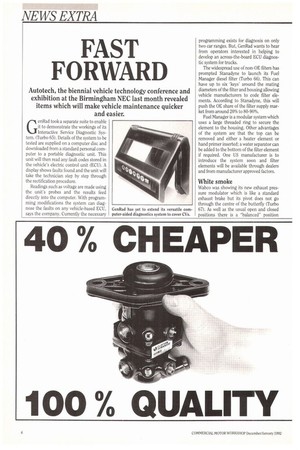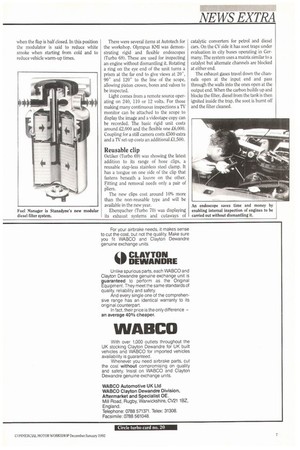FAST FORWARD
Page 74

Page 75

If you've noticed an error in this article please click here to report it so we can fix it.
GenRad took a separate suite to enable it to demonstrate the workings of its Interactive Service Diagnostic System. (Turbo 65). Details of the system to be tested are supplied on a computer disc and downloaded from a standard personal computer to a portable diagnostic unit. This unit will then read any fault codes stored in the vehicle's electric control unit (ECU). A display shows faults found and the unit will take the technician step by step through the rectification procedure.
Readings such as voltage are made using the unit's probes and the results feed directly into the computer. With programming modifications the system can diagnose the faults on any vehicle-based ECU, says the company. Currently the necessary programming exists for diagnosis on only two car ranges. But, GenRad wants to hear from operators interested in helping to develop an across-the-board ECU diagnostic system for trucks.
The widespread use of non-OE filters has prompted Stanadyne to launch its Fuel Manager diesel filter (Turbo 66). This can have up to six 'keys' around the mating diameters of the filter and housing allowing vehicle manufacturers to code filter elements. According to Stanadyne, this will push the OE share of the filter supply market from around 20% to 80-90%.
Fuel Manager is a modular system which uses a large threaded ring to secure the element to the housing. Other advantages of the system are that the top can be removed and either a heater element or hand primer inserted; a water separator can be added to the bottom of the filter element if required. One US manufacturer is to introduce the system soon and filter elements will be available through dealers and from manufacturer approved factors.
Wabco was showing its new exhaust pressure modulator which is like a standard exhaust brake but its pivot does not go through the centre of the butterfly (Turbo 67). As well as the usual open and closed positions there is a "balanced" position
when the flap is half closed. In this position the modulator is said to reduce white smoke when starting from cold and to reduce vehicle warm-up times.
There were several items at Autotech for the workshop. Olympus KMI was demonstrating rigid and flexible endoscopes (Turbo 68). These are used for inspecting an engine without dismantling it. Rotating a ring on the eye end of the unit turns a prism at the far end to give views at 20', 90° and 1200 to the line of the scope, allowing piston crown, bores and valves to be inspected.
Light comes from a remote source operating on 240, 110 or 12 volts. For those making many continuous inspections a TV monitor can be attached to the scope to display the image and a videotape copy can be recorded. The basic rigid unit costs around £2,000 and the flexible one £6,000. Coupling for a still camera costs £500 extra and a TV set-up costs an additional £1,500.
Oetiker (Turbo 69) was showing the latest addition to its range of hose clips, a reusable step-less stainless steel clamp. It has a tongue on one side of the clip that fastens beneath a louvre on the other. Fitting and removal needs only a pair of pliers.
The new clips cost around 10% more than the non-reusable type and will be available in the new year.
Eberspacher (Turbo 70) was displaying its exhaust systems and cutaways of
catalytic converters for petrol and diesel cars. On the CV side it has soot traps under evaluation in city buses operating in Germany. The system uses a matrix similar to a catalyst but alternate channels are blocked at either end.
The exhaust gases travel down the channels open at the input end and pass through the walls into the ones open at the output end. When the carbon builds up and blocks the filter, diesel from the tank is then ignited inside the trap, the soot is burnt off and the filter cleaned.




























































































